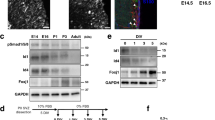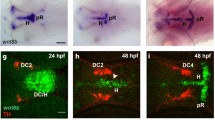Abstract
Bone morphogenetic proteins (BMPs), negative regulators of neural determination in the early embryo, were found to be potent inhibitors of neurogenesis in olfactory epithelium (OE) cultures. BMPs 2, 4 or 7 decreased the number of proliferating progenitor cells and blocked production of olfactory receptor neurons (ORNs). Experiments suggested that this effect was due to an action of BMPs on an early-stage progenitor in the ORN lineage. Further analysis revealed that progenitors exposed to BMPs rapidly (< 2 h) lost MASH1, a transcription factor known to be required for the production of ORNs. This disappearance was due to proteolysis of existing MASH1 protein, but new gene expression was required to trigger it. The data suggest a novel mechanism of BMP action, whereby the induced degradation of an essential transcription factor results in premature termination of a neuronal lineage.
This is a preview of subscription content, access via your institution
Access options
Subscribe to this journal
Receive 12 print issues and online access
$209.00 per year
only $17.42 per issue
Buy this article
- Purchase on Springer Link
- Instant access to full article PDF
Prices may be subject to local taxes which are calculated during checkout





Similar content being viewed by others
References
Caviness, V. S., Takahashi, T. & Nowakowski, R. S. Numbers, time and neocortical neuronogenesis: a general developmental and evolutionary model. Trends Neurosci. 18, 379–383 (1995).
Temple, S. & Qian, X. bFGF, neurotrophins, and the control of cortical neurogenesis. Neuron 15, 249–252 (1995).
Schwartz-Levey, S., Chikaraishi, D. M. & Kauer, J. S. Characterization of potential precursor populations in the mouse olfactory epithelium using immunocytochemistry and autoradiography. J. Neurosci. 11, 3556– 3564 (1991).
Schwob, J. E., Szumowski, K. E. M. & Stasky, A. A. Olfactory sensory neurons are trophically dependent on the olfactory bulb for their prolonged survival. J. Neurosci. 12, 3896–3919 (1992).
Gordon, M. K., Mumm, J. S., Davis, R. A., Holcomb, J. D. & Calof, A. L. Dynamics of MASH1 expression in vitro and in vivo suggest a non-stem cell site of MASH1 action in the olfactory receptor neuron lineage. Mol. Cell. Neurosci. 6, 363–379 (1995).
Mumm, J. S., Shou, J. & Calof, A. L. Colony-forming progenitors from mouse olfactory epithelium: Evidence for feedback regulation of neuron production. Proc. Natl. Acad. Sci. USA 93, 11167–11172 (1996).
Reh, T. A. & Tully, T. Regulation of tyrosine hydroxylase-containing amacrine cell number in larval frog retina. Dev. Biol. 114, 463–469 (1986).
Hawley, S. H. B. et al. Disruption of BMP signals in embryonic Xenopus ectoderm leads to direct neural induction. Genes Dev. 9, 2923–2935 (1995).
Wilson, P. A. & Hemmati-Brivanlou, A. Induction of epidermis and inhibition of neural fate by Bmp-4. Nature 376, 331–336 (1995).
Furuta, Y., Piston, D. W. & Hogan, B. L. Bone morphogenetic proteins (BMPs) as regulators of dorsal forebrain development. Development 124, 2203–2212 (1997).
Li, W., Cogswell, C. A. & LoTurco, J. J. Neuronal differentiation of precursors in the neocortical ventricular zone is triggered by BMP. J. Neurosci. 18, 8853–8862 (1998).
Graham, A., Francis-West, P., Brickell, P. & Lumsden, A. The signaling molecule BMP4 mediates apoptosis in the rhombencephalic neural crest. Nature 372, 684– 686 (1994).
Calof, A. L., Mumm, J. S., Rim, P. C. & Shou, J. in The Neuron in Tissue Culture (ed. Haynes, L.) 23–44 (Wiley, Chichester, 1999).
DeHamer, M., Guevara, J., Hannon, K., Olwin, B. & Calof, A. L. Genesis of olfactory receptor neurons: Regulation of progenitor cell divisions by fibroblast growth factors. Neuron 13, 1083–1097 (1994).
Holcomb, J. D., Mumm, J. S. & Calof, A. L. Apoptosis in the neuronal lineage of the mammalian olfactory epithelium: regulation in vivo and in vitro. Dev. Biol. 172, 307–323 (1995).
Dewulf, N. et al. Distinct spatial and temporal expression patterns of two type I receptors for bone morphogenetic proteins during mouse embryogenesis. Endocrinology 136, 2652– 2663 (1995).
Helder, M. N. et al. Expression pattern of Osteogenic Protein-1 (Bone Morphogenetic Protein-7) in human and mouse development. J. Histochem. Cytochem. 43, 1035–1044 (1995).
Zhang, D., Mehler, M. F., Song, Q. & Kessler, J. A. Development of bone morphogenetic protein receptors in the nervous system and possible roles in regulating trkC expression. J. Neurosci. 18, 3314–3326 (1998).
Wu, D. K. & Oh, S.-H. Sensory organ generation in the chick inner ear. J. Neurosci. 16, 6454– 6462 (1996).
Kingsley, D. M. The TGF-β superfamily: new members, new receptors, and new genetic tests of function in different organisms. Genes Dev. 8, 133–146 (1994).
Arkell, R. & Beddington, R. S. P. BMP-7 influences pattern and growth of the developing hindbrain of mouse embryos. Development 124, 1–12 (1997).
Calof, A. L., Mumm, J. S., Rim, P. C. & Shou, J. The neuronal stem cell of the olfactory epithelium. J. Neurobiol. 36, 190–205 (1998).
Calof, A. L. et al. Factors regulating neurogenesis and programmed cell death in mouse olfactory epithelium. Ann. NY Acad. Sci. 855, 226–229 (1998).
Pixley, S. K. CNS glial cells support in vitro survival, division, and differentiation of dissociated olfactory neuronal progenitor cells. Neuron 8, 1191–1204 (1992).
Calof, A. L. & Chikaraishi, D. M. Analysis of neurogenesis in a mammalian neuroepithelium: proliferation and differentiation of an olfactory neuron precursor in vitro. Neuron 3, 115–127 (1989).
Cau, E., Gradwohl, G., Fode, C. & Guillemot, F. Mash1 activates a cascade of bHLH regulators in olfactory neuron progenitors. Development 124, 1611–1621 (1997).
Guillemot, F. et al. Mammalian achaete-scute homolog 1 is required for the early development of olfactory and autonomic neurons. Cell 75, 463–476 (1993).
Lo, L. C., Johnson, J. E., Wuenschell, C. W., Saito, T. & Anderson, D. J. Mammalian achaete-scute homolog 1 is transiently expressed by spatially restricted subsets of early neuroepithelial and neural crest cells. Genes Dev. 5, 1524–1537 (1991).
Zimmerman, L. B., De Jesus-Escobar, J. M. & Harland, R. M. The Spemann organizer signal noggin binds and inactivates bone morphogenetic protein 4. Cell 86, 599–606 (1996).
Weissman, A. M. Regulating protein degradation by ubiquitination. Immunol. Today 18, 189–198 (1997).
Rock, K. L. et al. Inhibitors of the proteasome block the degradation of most cell proteins and the generation of peptides presented on MHC class I molecules. Cell 78, 761–771 (1994).
Fenteany, G. et al. Inhibition of proteasome activities and subunit-specific amino-terminal threonine modification by lactacystin. Science 268, 726–731 (1995).
Kretzschmar, M. & Massague, J. SMADs: mediators and regulators of TGF-β signaling. Curr. Opin. Genet. Dev. 8, 103–111 (1998).
Lo, L. C., Sommer, L. & Anderson, D. J. MASH1 maintains competence for BMP2-induced neuronal differentiation in post-migratory neural crest cells. Curr. Biol. 7, 440–450 (1997).
Varley, J. E., Wehby, R. G., Rueger, D. C. & Maxwell, G. D. Number of adrenergic and Islet-1 immunoreactive cells is increased in avian trunk neural crest cultures in the presence of human recombinant Osteogenic Protein-1. Develop. Dynam. 203, 434– 447 (1995).
Gross, R. E. et al. Bone morphogenetic proteins promote astroglial lineage commitment by mammalian subventricular zone progenitor cells. Neuron 17, 595–606 (1996).
Shah, N. M., Groves, A. K. & Anderson, D. J. Alternative neural crest cell fates are instructively promoted by TGFβ superfamily members. Cell 85, 331–343 (1996).
Marazzi, G., Wang, Y. & Sassoon, D. Msx2 is a transcriptional regulator in the BMP4-mediated programmed cell death pathway. Dev. Biol. 186, 127–138 (1997).
Ström, A., Castella, P., Rockwood, J., Wagner, J. & Caudy, M. Mediation of NGF signaling by post-translation inhibition of HES-1, a basic helix-loop-helix repressor of neuronal differentiation. Genes Dev. 11, 3168–3181 (1997).
Engel, M. E., Datta, P. K. & Moses, H. L. RhoB is stabilized by transforming growth factor β and antagonizes transcriptional activation. J. Biol. Chem. 273, 9921–9926 (1998).
Alkalay, I. et al. Stimulation-dependent IκBa phosphorylation marks the NF-κB inhibitor for degradation via the ubiquitin-proteasome pathway. Proc. Natl. Acad. Sci. USA 92, 10599– 10603 (1995).
Kanegae, Y., Tavares, A. T., Belmonte, J. C. I. & Verma, I. M. Role of Rel/NF-κB transcription factors during the outgrowth of the vertebrate limb. Nature 392, 611– 614 (1998).
Bushdid, P. B. et al. Inhibition of NF-κB activity results in disruption of the apical ectodermal ridge and aberrant limb morphogenesis. Nature 392, 615–618 (1998).
Aberle, H., Bauer, A., Stappert, J., Kispert, A. & Kemler, R. β-catenin is a target for the ubiquitin-proteasome pathway. EMBO J. 16, 3797– 3804 (1997).
Lee, J. E. Basic helix-loop-helix genes in neural development. Curr. Opin. Neurobiol. 7, 13–20 (1997).
Sambrook, J., Fritsch, E. F. & Maniatis, T. Molecular Cloning: A Laboratory Manual. (Cold Spring Harbor Press, Cold Spring Harbor, New York, 1989).
Kim, S., Magendantz, M., Katz, W. & Solomon, F. Formation of the chicken erythrocyte marginal band in vivo: orgins of a cytoplasmic microtubule structure. J. Cell Biol. 104, 51–59 (1987).
Clark, M. S., Lanigan, T. M., Page, N. M. & Russo, A. F. Induction of a serotonergic and neuronal phenotype in thyroid C-cells. J. Neurosci. 15, 6167–6178 (1995).
Magae, J. et al. Transcriptional squelching by ectopic expression of E2F-1 and p53 is alleviated by proteasome inhibitors MG-132 and lactacystin. Oncogene 15, 759–769 (1997).
Acknowledgements
The authors are grateful to Youn Kim for help with experiments, and to Arthur Lander for suggestions regarding these studies. We thank Genetics Institute for the gift of recombinant human BMPs, Richard Harland for the gift of recombinant Xenopus noggin, David Anderson for anti-MASH1 hybridoma and Frank Solomon for rabbit antiserum to β-tubulin. This work was supported by a grant to A.L.C. from the Institute on Deafness and Other Communication Disorders of the N.I.H. (DC03583).
Author information
Authors and Affiliations
Corresponding author
Rights and permissions
About this article
Cite this article
Shou, J., Rim, P. & Calof, A. BMPs inhibit neurogenesis by a mechanism involving degradation of a transcription factor. Nat Neurosci 2, 339–345 (1999). https://doi.org/10.1038/7251
Received:
Accepted:
Issue Date:
DOI: https://doi.org/10.1038/7251
This article is cited by
-
Unraveling the differential dynamics of developmental fate in central and peripheral nervous systems
Scientific Reports (2016)
-
Translational potential of olfactory mucosa for the study of neuropsychiatric illness
Translational Psychiatry (2015)
-
p57Kip2 is a repressor of Mash1 activity and neuronal differentiation in neural stem cells
Cell Death & Differentiation (2009)
-
Olfactory epithelium progenitors: insights from transgenic mice and in vitro biology
Journal of Molecular Histology (2007)
-
BMP-2 decreases Mash1 stability by increasing Id1 expression
The EMBO Journal (2004)



